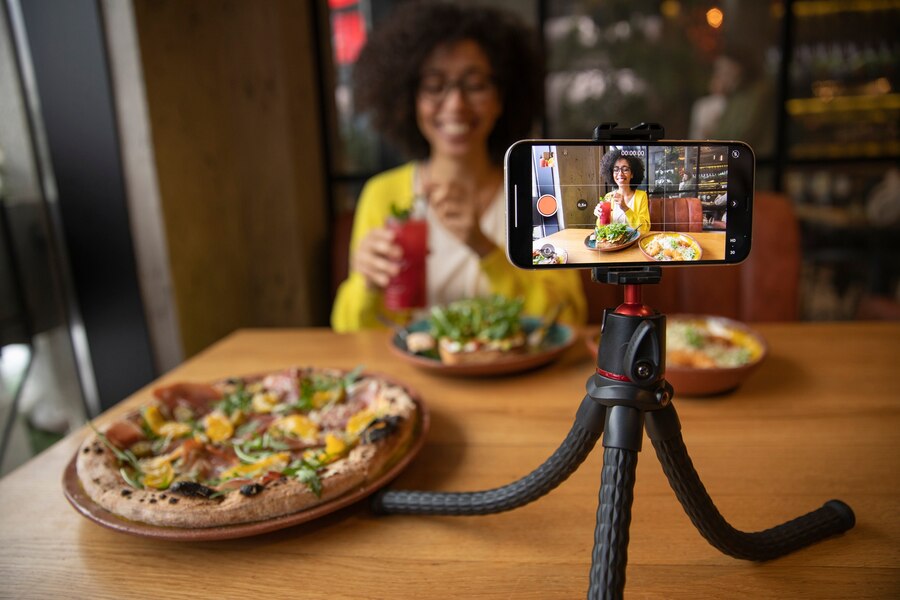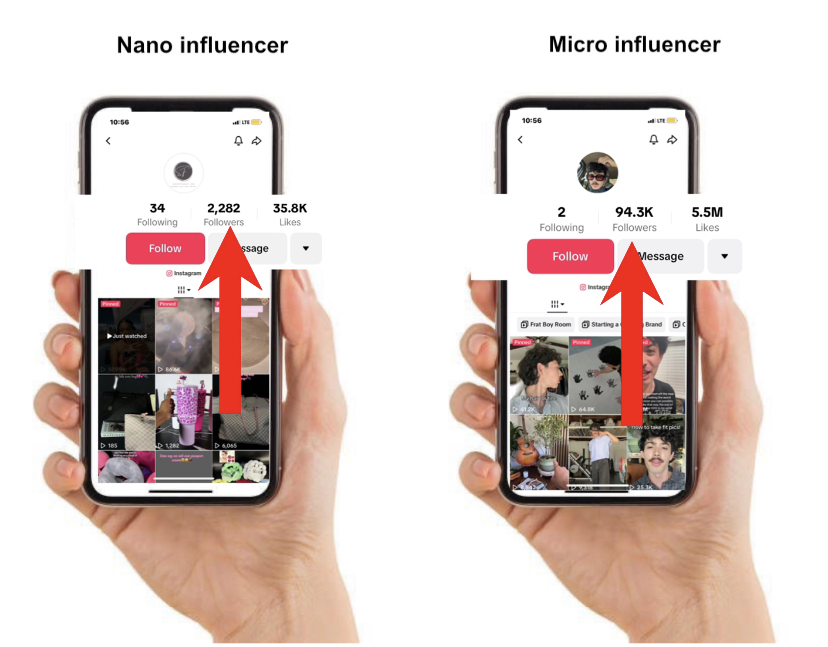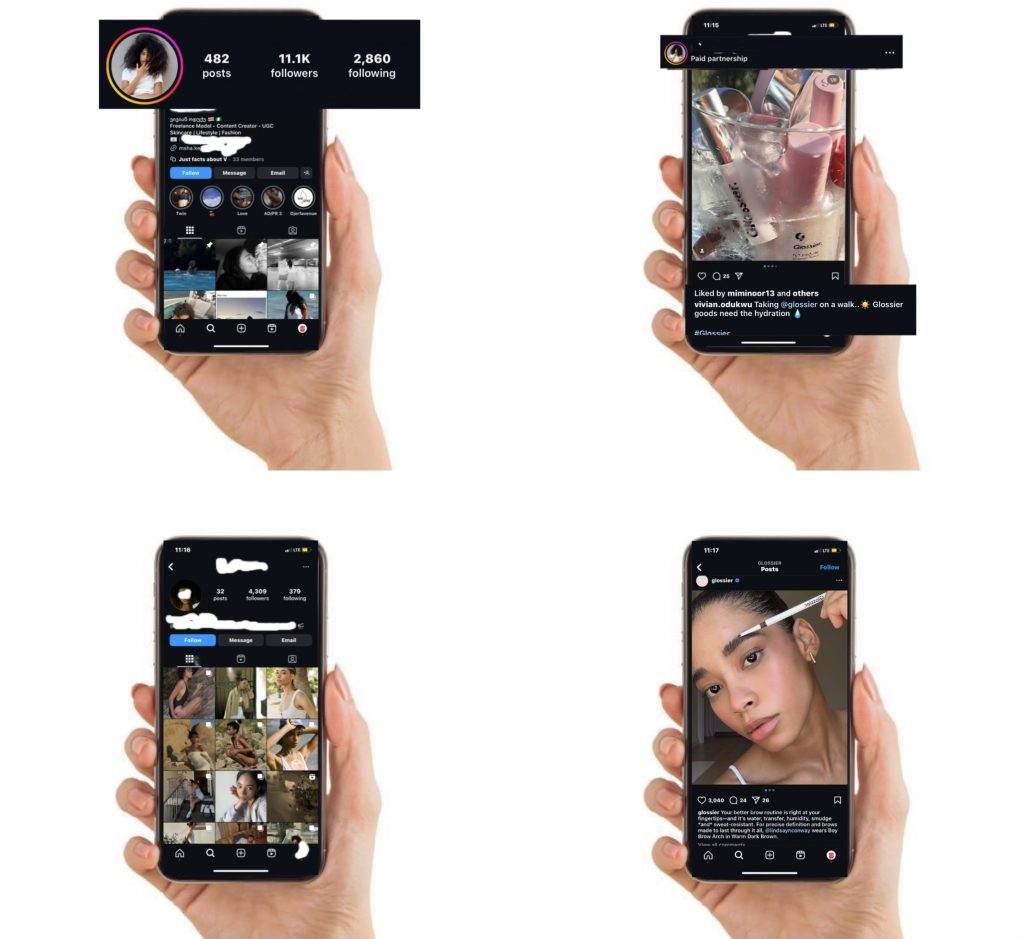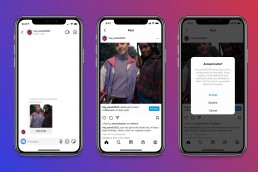Influencer marketing has come a long way since its early days. Originally, brands relied heavily on celebrities and big-name influencers to promote their products.
These macro-influencers have millions of followers. Making them appealing to businesses seeking wide exposure.
However, as social media evolves, the focus is shifting to small-scale influencers. This shift opens new avenues for brands that want to use social media to market in ways that resonate with consumers.

Therefore, this blog post will explore the rise of micro and nano influencers. We’ll discuss their effectiveness and differences in social media influencer marketing. Also, we’ll cover how brands can use them for better engagement.
The rise of micro and nano influencers
A major trend in influencer marketing is the rise of micro and nano influencers. Here is a breakdown of these influencers: their benefits and how they differ.
What are micro- and nano-influencers?
Any influencer with 10,000 to 100,000 followers on Instagram, TikTok, YouTube, or any social media platform is referred to as a micro-influencer.
Social media micro-influencers have a reputation for their expertise and content. They can lead discussions, write blogs, or own small businesses.
Nano-influencers are individuals with fewer than 10,000 followers on social media. These individuals might be either skilled experts or fans of a brand.

Benefits of investing in micro- or nano-influencers.
Micro and nano influencers embody your brand with genuineness. They have smaller, more engaged audiences.
These influencers also provide a higher return on investment. They need fewer resources and less pay than larger influencers.
Also, micro and nano influencers can help brands target their audience better. They often have a specific niche or expertise.
Furthermore, brand collaborations with micro-influencers and nano will be more flexible. This includes long-term partnerships or sponsored content series.
Key differences between micro- and nano-influencers.

The following are the major differences between nano- and micro-influencers:
- Micro-influencers have a wider reach than nano-influencers. But they may not have the same level of engagement.
- Content style: Micro-influencers create polished content. Nano-influencers may produce raw, unedited work.
- Expertise: Micro-influencers have a specific expertise. Nano-influencers have broader interests.
- Audience demographics: Micro-influencers have a more diverse audience. Nano-influencers have a very specific one.
Why micro and nano influencers are more effective for small brands
You must be wondering, “Why the sudden change?” Well, it is very simple. Brands are tired of poor results despite spending a lot of money. But, to explore this more, here are some reasons.
Why invest in nano-influencers:
One cannot underestimate the large scale of nano-influencer impact. They work in creating personal relationships within communities. This enables them to craft content that strikes a chord with followers.

Studies show that 89% of consumers trust personal recommendations over ads. Thus, nano influencers are ideal for creating these authentic connections.
Their close-knit communities foster high trust. This boosts conversion rates for brands that collaborate with them.
Why invest in micro-influencers:
Micro-influencers excel in niche markets. Their ability to create niche content lets brands reach a targeted audience.
For example, a skincare brand that partners with a micro-influencer that focuses on organic products will get more engagement than a skincare brand that partners with micro-influencers that focus on smart appliances or gadgets.
Engagement rates: micro- vs. nano-influencers
A key metric in marketing is influencer engagement rates. It measures how much followers interact with content.
Micro-influencers can have engagement rates of 3% to 10%. Nano-influencers can exceed 10%. This shows that smaller influencers often have better engagement rates.
Their followers tend to interact more with their content. This appeals to brands who want a true connection and elevate their messaging.

Brand-influencer partnerships: finding the right fit
The choice between micro and nano influencers depends on a brand’s marketing goals. For businesses seeking wide reach, a few micro-influencers may work better. Brands wanting to reach a very engaged audience should use nano influencers.
However, if you use both micro and nano influencers, you’ll be able to maximise your brand’s reach and impact.
Challenges in working with micro and nano-influencers
The potential benefits are huge. However, there are challenges with micro and nano influencers.
These may include difficulty in identifying suitable partners or managing many collaborations simultaneously.
However, platforms for influencer discovery and management can help. For instance, using 50 Pound Social can improve your influencer partnerships. We will ensure efficient communication and engagement.

Best practices for working with micro and nano influencers
To succeed with micro and nano influencers, follow these best practices.
- Identify your target audience. Find micro and nano influencers who align with it.
- Research the influencer’s content, engagement, and audience demographics before partnering with them.
- Set realistic expectations for the campaign. This includes what you expect from the influencer’s content and promotion.
- Clear communication: Set clear channels with the influencer. They must understand your brand’s messaging and goals.
- Establish precise campaign objectives with the influencer to guide the campaign.
- Check the influencer’s performance. Track the campaign’s success using metrics like engagement and conversion rates.
The success story of micro and nano-influencer campaigns
Several brands have successfully used micro and nano in their influencer marketing strategies. A popular makeup line, Glossier, hired many micro-influencers to show its products.

This led to a big rise in sales and social media chatter. These cases show the power of smaller influencers in driving brand engagement.
Wrapping up: Choose the right influencer strategy for your brand.
Rather than merely following the trend of macro influencers, you should evaluate your marketing strategies to integrate either micro or nano influencers.
By doing so, you can build real connections with your audiences, drive engagement, and keep a competitive edge in the dynamic world of social media influencer marketing.
Also, it can be hard to choose and manage the right micro-influencers for your brand. So, if you know you don’t have time to do all this, visit 50 Pound Social Plans. We tailor community management and Instagram Mega Boost Service for small businesses.
For insights on social media influencer trends, read this. It’ll explain the impact of influencers on today’s marketing.
Kamran Shukurlu
Kamran is a T-shaped eCommerce Digital Marketer and Content Strategist with 9+ years of experience in 30+ industries. A few of the companies that benefited from his services: Leo Burnett, Translated, Airbnb, Samsung, Huawei, etc.
Related Posts
March 24, 2025
Leveraging X’s Subscription Feature for Monetisation
March 13, 2025
Maximising Engagement with Instagram’s New DM Features
February 22, 2025
LinkedIn Polls: How to Use Audience Insights to Boost Engagement
February 12, 2025
Pinterest for Influencers: How to Monetise Your Audience
December 24, 2024
TikTok Duets and Stitch: Innovative Ways to Collaborate and Engage
December 13, 2024
Unlock viral pins with Click-Worthy Pinterest graphics
December 2, 2024
6 Ways to Perform Social Media Competitor Analysis
November 23, 2024
TikTok Advertising Best Practices
October 25, 2024
How to Use Instagram Broadcast Channels for Brand Engagement
October 11, 2024
Using Augmented Reality Filters in Social Media Campaigns
October 4, 2024
Why Instagram Is Good for Marketing: Engaging Your Audience
September 17, 2024
The Impact of Smooth Transactions on Your Brand Reputation
September 11, 2024
Building Brand Loyalty Through Private Social Media Groups
September 2, 2024
Creating Shareable Personalised Content
August 28, 2024
The Secret TikTok Viral Recipe in 2024
August 17, 2024
Harnessing the Power of User-Generated Content in 2024
August 8, 2024
Creating an Effective Social Media Content Strategy
July 18, 2024
Social SEO: Optimising Your Content for Discovery
July 8, 2024
The Comeback of Long-Form Content
June 5, 2024
How to Import Sounds From TikTok to Instagram?
May 21, 2024
9 TikTok Challenges List And TikTok Trends
February 24, 2024
Pinterest Account Suspended Appeal – How To Do It Right?
February 3, 2024
How to Make Money With Instagram Theme Pages In 2024
January 11, 2024
Resort And Hotel Digital Marketing Campaign Strategy And Ideas
December 26, 2023
New Year and Christmas Interactive Posts and Ideas For Social Media
December 8, 2023
B2B Community Management: Unpopular Opinion To Level Up
November 23, 2023
Feel Good Friday Social Media Posts And Wishes
October 6, 2023
How to Stream Games on TikTok With TikTok Stream Key
September 15, 2023
Creating an Effective Content Calendar
September 15, 2023
10 Tips to Optimize Facebook Page for SEO and Reach More People
September 4, 2023
How to Go Live on TikTok Without 1000 Followers In 2023
August 14, 2023
How Much Does IG Models Make And How To Become One
June 26, 2023
How To Get Verified On LinkedIn In 2023?
March 25, 2023
How to Create a Facebook Group Funnel to Drive Leads
March 19, 2023
How to Mass Archive Instagram Posts in 2023 + Unarchive
March 13, 2023
8 Social Media Community Building Strategies For 2023
February 18, 2023
How To Make Money On Instagram With 500 Followers
February 18, 2023
How to Go Live on LinkedIn – Best Practices and Guides
February 8, 2023
Instagram Guides Examples and Ways to Use Them
February 8, 2023
How to Schedule Instagram Posts Without Third-party App
January 22, 2023
Growth Hacking for Instagram to Get More Followers in 2023
January 20, 2023
How To Upload GIFs on Twitter in 2023
January 3, 2023
What To Do When you go Viral on Instagram
December 23, 2022
How to Spy on Competitors’ Facebook Ads For Free (6 Tools)
December 22, 2022
How to Get More Views on LinkedIn – 10 Tips to Reach More People
December 19, 2022
What To Do Before and After Posting On Instagram
December 14, 2022
How Instagram Search Works: A Comprehensive Guide In 2022
November 15, 2022
Twitter Spaces Analytics: Ultimate Guide to Your Space Insights
November 13, 2022
20 Viral Instagram Reels Hooks To Keep People Watching
October 29, 2022
How To Speed Up Existing Video For Instagram Reels – FOR FREE
October 16, 2022
How to Use Twitter Advanced Search Tool on Mobile
October 16, 2022
7 Instagram Mistakes to Avoid & Here’s Why
October 9, 2022
10 Proven Instagram Story Ideas to Engage Your Audience
September 23, 2022
Social Media Shopping in 2022: What it Promises for Small Businesses
September 20, 2022
Tips to Create a Successful Hashtag Campaign
September 8, 2022
The Top 9 Instagram Tools That Can Boost Your SME’s Visibility
August 28, 2022
How to Regram: The Art of Reposting on Instagram
August 11, 2022
A Checklist to Launch a Rebrand on Social Media
August 7, 2022
The Whys and Hows of Facebook Video Ads
August 7, 2022
How To Write Good Instagram Captions
July 27, 2022
How to Plan Your Social Media Campaigns
May 4, 2022
10 Social Media Myths To Unlearn in 2022
April 11, 2022
Twitter Analytics Tools to Level Up Your Game
March 14, 2022
Monthly Social Media Updates And News – February 2022
February 23, 2022
Social Media in the times of COVID-19: Adapting to a New Normal
February 14, 2022
Monthly Social Media Updates And News – January 2022
February 2, 2022
Optimise Google My Business: An In-depth Guide to Get it Right
January 19, 2022
9 Tips to Sell on Pinterest: Your Branding And ROI Booster
January 12, 2022
Monthly Social Media Updates And News – December 2021
December 10, 2021
Risks And Dangers of Buying Instagram Followers
December 8, 2021
Monthly Social Media Updates And News – November 2021
November 2, 2021
Monthly Social Media Updates And News – October 2021
October 14, 2021
Monthly Social Media Updates And News – September 2021
October 1, 2021
Brief 18 Twitter Hacks You’ll Wish You Knew Earlier
September 23, 2021
Instagram Pre-Launch Strategy 2022: A Proper Guide for Your Product
September 14, 2021
Monthly Social Media Updates And News – August 2021
September 8, 2021
15 Social Media Post Types to Keep Your Content Engaging
September 8, 2021
How to Sell on Facebook Shops and Facebook Marketplace in 2023
August 16, 2021
Driving Traffic From Twitter Straight to Your Blog in 2022
August 13, 2021
The ABCs of Using LinkedIn Videos Like a Pro in 2022
August 11, 2021
Monthly Social Media Updates And News – July 2021
July 29, 2021
Spiral Up Your Engagements With Instagram Carousels
July 17, 2021
Monthly Social Media Updates And News – May 2021
July 5, 2021
How to Mass Delete Instagram Posts in 2022?
April 29, 2021
Monthly Social Media Updates And News: March 2021
April 17, 2021
Latest Social Media Updates And News – 2022
April 17, 2021
Monthly Social Media Updates And News: February 2021
March 31, 2021
How to Choose the Best Competitor Analysis Framework
March 1, 2021
Monthly Social Media Updates And News: January 2021
February 21, 2021
How To Get Unlimited Free Leads For Any Business In UK
February 20, 2021
How to Find Brands That Collaborate With Small Influencers
February 4, 2021
Web Content Development 101 For Small Businesses
January 28, 2021
Monthly Social Media Updates and News: December 2020
January 13, 2021
How To Add A Link To Instagram Story Without 10K Followers
December 14, 2020
6 Testimonial Examples And How To Ask For Them
December 11, 2020
IG Line Break Generator: No Need For it Anymore? (2022)
December 2, 2020
Monthly Social Media News And Updates: November 2020
April 22, 2020
Social media marketing for recruitment agencies
December 23, 2019
How to market your podcast on social media
October 31, 2019
Account-based mindset vs. lead-based marketing
October 22, 2019
The benefits of starting your own podcast
October 14, 2019
What’s the LinkedIn Social Selling Index? (and why you need it)
October 8, 2019
7 ideas to network effectively – and locally
September 26, 2019
5 tips from an influencer to unlock your potential
September 16, 2019
How to create an effective Facebook ad: 7 easy tips
September 7, 2019
3 inspiring marketing campaigns with awesome results
September 1, 2019
Everything you need to know about lead generation
August 28, 2019
Can my brand benefit from a social media calendar?
August 13, 2019
3 basics of KPIs: what to measure and why?
August 9, 2019
5 Story Highlight ideas to totally revamp your Instagram
July 31, 2019
The good, the bad, and the funnel
July 24, 2019
The basics of content marketing – why you need it
July 18, 2019
Primark – how the brand uses social media
July 10, 2019
The evolution of Twitter for social media marketing
July 7, 2019
Discover 3 benefits of WhatsApp Business!
June 28, 2019
How Lululemon uses social media: 5 ideas
June 24, 2019
New Instagram @shop and how it works
June 17, 2019
5 foolproof tools to create a buyer persona
May 29, 2019
3 burning social media trends to watch out for
May 23, 2019
7 ingredients every entrepreneur needs to have
May 13, 2019
5 Social Media Tools: Marketing Made Easy!
April 15, 2019
Wanna kickstart your landing page? 3 reliable tools!
March 26, 2019
3 video marketing tricks to boost engagement
February 26, 2019
A five-star femmepreneur – meet Gretta van Riel!
February 15, 2019
Why Twitter is essential – revamp your marketing strategy today!
February 7, 2019
SEO for Newbies: The Basics
January 22, 2019
4 amazing inbound marketing tools to try now!
January 16, 2019
Everything about ecommerce, decoded!
January 11, 2019
Influencer marketing: why is it crucial?
January 7, 2019
How social media is changing your brain
January 2, 2019
Choosing a signature colour for your brand
December 28, 2018
Advanced Instagram for startups: an effective step-by-step guide
December 1, 2018
Instagram from Scratch!
November 22, 2018
Elevate your Brand with these 4 New Linkedin Tools
January 15, 2018
5 Ways Social Media Can Help Your Small Business In 2018
September 25, 2017
7 indispensable social media tools for small businesses
September 1, 2017
September 2017: Social Media Roundup
February 2, 2017
Our new promotional video
January 17, 2017
Why your business needs to be active on social media
November 3, 2016
The Top 10 Small Fashion Brands on Instagram
September 29, 2016
Hоw Tо Grоw Yоur Smаll Business Uѕing Social Media
September 26, 2016
How can I use social media for customer service?
September 20, 2016







































































































































































































